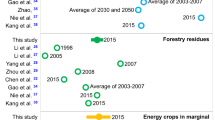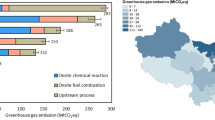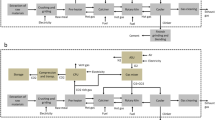Abstract
Given that the global fleet of coal-fired power plants is mostly new, coal–biomass co-firing power plants with retrofitted carbon capture and storage (CBECCS) are regarded as a promising option for CO2 emissions reduction. However, the effectiveness of CBECCS remains largely unexplored. Here we develop a comprehensive assessment framework featuring a macro power system combined with spatially explicit biomass sources, coal-fired units and geological storage sites. We apply this framework to investigate the spatiotemporal deployment of CBECCS in China. The results indicate that a transition to CBECCS in 2025 could supply 0.97 GtCO2 yr–1 sequestration potential, with 90% at a levelized cost between $30 and $50 tCO2–1. A higher CO2 mitigation of 1.6 Gtyr–1 could be achieved in 2040 by increasing the unit utilization hours, corresponding to a cumulative contribution of 41.2 GtCO2 over the period 2025–2060. This study provides a useful reference for transforming coal-dominated power systems.
This is a preview of subscription content, access via your institution
Access options
Access Nature and 54 other Nature Portfolio journals
Get Nature+, our best-value online-access subscription
$29.99 / 30 days
cancel any time
Subscribe to this journal
Receive 12 print issues and online access
$209.00 per year
only $17.42 per issue
Buy this article
- Purchase on Springer Link
- Instant access to full article PDF
Prices may be subject to local taxes which are calculated during checkout






Similar content being viewed by others
Data availability
The datasets used in this study are available online at https://doi.org/10.17632/xrf3h89t73.2 and can also be obtained from fan@cumtb.edu.cn upon reasonable request. Source data are provided with this paper.
Code availability
The codes used in this study are available online at https://doi.org/10.17632/tt7pc5s72k.2 and can also be obtained from fan@cumtb.edu.cn upon reasonable request.
References
China Power Industry Development Report 2022 (CEC, 2022).
Boom and Bust Coal 2022 (Global Energy Monitor, 2022).
Fan, J.-L., Xu, M., Li, F., Yang, L. & Zhang, X. Carbon capture and storage (CCS) retrofit potential of coal-fired power plants in China: the technology lock-in and cost optimization perspective. Appl. Energy 229, 326–334 (2018).
Jewell, J., Vinichenko, V., Nacke, L. & Cherp, A. Prospects for powering past coal. Nat. Clim. Change 9, 592–597 (2019).
Jakob, M. et al. The future of coal in a carbon-constrained climate. Nat. Clim. Change 10, 704–707 (2020).
Bui, M., Fajardy, M. & Mac Dowell, N. Bio-energy with CCS (BECCS) performance evaluation: efficiency enhancement and emissions reduction. Appl. Energy 195, 289–302 (2017).
Fletcher, K. in Drax’s 2014 results show decarbonization project on time, budget. https://www.woodpelletservices.com/documents/Drax%20FEB2015.pdf (WPS, 2015).
Savolainen, K. Co-firing of biomass in coal-fired utility boilers. Appl. Energy 74, 369–381 (2003).
Sanchez, D. L. & Kammen, D. M. A commercialization strategy for carbon-negative energy. Nat. Energy 1, 15002 (2016).
Milne, J. L & Field, C. B. Assessment Report from the GCEP Workshop on Energy Supply with Negative Carbon Emissions (Stanford University, 2012).
Smith, P. et al. Biophysical and economic limits to negative CO2 emissions. Nat. Clim. Change 6, 42–50 (2016).
Jones, M. B. & Albanito, F. Can biomass supply meet the demands of bioenergy with carbon capture and storage (BECCS)? Glob. Change Biol. 26, 5358–5364 (2020).
Anderson, K. & Peters, G. The trouble with negative emissions. Science 354, 182–183 (2016).
Heck, V., Gerten, D., Lucht, W. & Popp, A. Biomass-based negative emissions difficult to reconcile with planetary boundaries. Nat. Clim. Change 8, 151–155 (2018).
Fuhrman, J. et al. Food–energy–water implications of negative emissions technologies in a +1.5 °C future. Nat. Clim. Change 10, 920–927 (2020).
Babin, A., Vaneeckhaute, C. & Iliuta, M. C. Potential and challenges of bioenergy with carbon capture and storage as a carbon-negative energy source: a review. Biomass Bioenergy 146, 105968 (2021).
Agbor, E., Zhang, X. & Kumar, A. A review of biomass co-firing in North America. Renew. Sustain. Energy Rev. 40, 930–943 (2014).
The Role of CCUS in Low-Carbon Power Systems (IEA, 2020).
Basu, P., Butler, J. & Leon, M. A. Biomass co-firing options on the emission reduction and electricity generation costs in coal-fired power plants. Renew. Energy 36, 282–288 (2011).
Yang, B. et al. Life cycle cost assessment of biomass co-firing power plants with CO2 capture and storage considering multiple incentives. Energy Econ. 96, 105173 (2021).
Zantye, M. S., Arora, A. & Hasan, M. M. F. Renewable-integrated flexible carbon capture: a synergistic path forward to clean energy future. Energy Environ. Sci. 14, 3986–4008 (2021).
Global Status Report 2020 (GCCSI, 2021).
Bui, M. et al. Carbon capture and storage (CCS): the way forward. Energy Environ. Sci. 11, 1062–1176 (2018).
14th Five-Year Plan for Science and Technology Innovation in the Energy Sector (MOST and NEA, 2021); http://zfxxgk.nea.gov.cn/2021-11/29/c_1310540453.htm
National Implementation Plan for the Renovation and Upgrading of Coal Power Units (NDRC and NEA, 2021); from: https://www.ndrc.gov.cn/xxgk/zcfb/tz/202111/t20211103_1302856.html?code=&state=123
Science and Technology to Support Carbon Neutral Implementation Plan (2022–2030) (MOST, NDRC, MIIT and NEA, 2022); https://www.most.gov.cn/xxgk/xinxifenlei/fdzdgknr/qtwj/qtwj2022/202208/t20220817_181986.html
Rosa, L., Sanchez, D. L. & Mazzotti, M. Assessment of carbon dioxide removal potential via BECCS in a carbon-neutral Europe. Energy Environ. Sci. 14, 3086–3097 (2021).
Baik, E. et al. Geospatial analysis of near-term potential for carbon-negative bioenergy in the United States. Proc. Natl Acad. Sci. USA 115, 3290–3295 (2018).
Fajardy, M. & Mac Dowell, N. Can BECCS deliver sustainable and resource efficient negative emissions? Energy Environ. Sci. 10, 1389–1426 (2017).
Sanchez, D. L., Johnson, N., McCoy, S. T., Turner, P. A. & Mach, K. J. Near-term deployment of carbon capture and sequestration from biorefineries in the United States. Proc. Natl Acad. Sci. USA 115, 4875–4880 (2018).
Schakel, W., Meerman, H., Talaei, A., Ramírez, A. & Faaij, A. Comparative life cycle assessment of biomass co-firing plants with carbon capture and storage. Appl. Energy 131, 441–467 (2014).
Lu, X. et al. Gasification of coal and biomass as a net carbon-negative power source for environment-friendly electricity generation in China. Proc. Natl Acad. Sci. USA 116, 8206–8213 (2019).
Wang, R. et al. Retrofitting coal-fired power plants with biomass co-firing and carbon capture and storage for net zero carbon emission: a plant-by-plant assessment framework. Glob. Change Biol. Bioenergy 13, 143–160 (2021).
Xing, X. et al. Spatially explicit analysis identifies significant potential for bioenergy with carbon capture and storage in China. Nat. Commun. 12, 3159 (2021).
Tang, H., Zhang, S. & Chen, W. Assessing representative CCUS layouts for China’s power sector toward carbon neutrality. Environ. Sci. Technol. 55, 11225–11235 (2021).
Wei, Y.-M. et al. A proposed global layout of carbon capture and storage in line with a 2 °C climate target. Nat. Clim. Change 11, 112–118 (2021).
Statistical Review of World Energy 2022 (BP, 2022).
Ready for CCS Retrofit: The Potential for Equipping China’s Existing Coal Fleet with Carbon Capture and Storage (IEA, 2016).
Mac Dowell, N., Fennell, P. S., Shah, N. & Maitland, G. C. The role of CO2 capture and utilization in mitigating climate change. Nat. Clim. Change 7, 243–249 (2017).
China Natural Gas Development Report (NBS, 2022).
Total Greenhouse Gas Emission Trends and Projections in Europe (EEA, 2020).
Duan, H. et al. Assessing China’s efforts to pursue the 1.5 °C warming limit. Science 372, 378 (2021).
China Carbon Dioxide Capture, Utilization and Storage (CCUS) Annual Report (2021)—Study on the CCUS Pathway in China (CAEP, IRSM and ACCA21, 2021).
IPCC Climate Change 2021: The Physical Science Basis (eds Masson-Delmotte, V. et al.) (Cambridge Univ. Press, 2021).
IPCC Special Report on Global Warming of 1.5 °C (eds Masson-Delmotte, V. et al.) (WMO, 2018).
Bioenergy and Carbon Capture and Storage (GCCSI, 2019).
Al-Mansour, F. & Zuwala, J. An evaluation of biomass co-firing in Europe. Biomass Bioenergy 34, 620–629 (2010).
Carlsson J. et al. ETRI 2014 energy technology reference indicator projections for 2010–2050. https://publications.jrc.ec.europa.eu/repository/handle/JRC92496 (Publications Office of the European Union, 2014).
Konwar, K. et al. Effect of biomass addition on the devolatilization kinetics, mechanisms and thermodynamics of a northeast Indian low rank sub-bituminous coal. Fuel 256, 115926 (2019).
Bhuiyan, A. A. & Naser, J. CFD modelling of co-firing of biomass with coal under oxy-fuel combustion in a large scale power plant. Fuel 159, 150–168 (2015).
Cabral, R. P., Bui, M., Mac & Dowell, N. A synergistic approach for the simultaneous decarbonisation of power and industry via bioenergy with carbon capture and storage (BECCS). Int. J. Greenh. Gas Control 87, 221–237 (2019).
Fan, J.-L., Xu, M., Yang, L. & Zhang, X. Benefit evaluation of investment in CCS retrofitting of coal-fired power plants and PV power plants in China based on real options. Renew. Sustain. Energy Rev. 115, 109350 (2019).
The Role of CCUS in Low-Carbon Power Systems (IEA, 2020).
Zhang, Q., Zhou, D., Zhou, P. & Ding, H. Cost analysis of straw-based power generation in Jiangsu Province, China. Appl. Energy 102, 785–793 (2013).
Chakraborty, A. et al. Developing a spatial information system of biomass potential from crop residues over India: a decision support for planning and establishment of biofuel/biomass power plant. Renew. Sustain. Energy Rev. 165, 112575 (2022).
Koppejan, J. & Van Loo, S. The Handbook of Biomass Combustion and Co-firing (Routledge, 2012).
Miedema, J. H., Benders, R. M. J., Moll, H. C., & Pierie, F. Renew, reduce or become more efficient? The climate contribution of biomass co-combustion in a coal-fired power plant. Appl. Energy 187, 873–885 (2017).
Baik, E. et al. Geospatial analysis of near-term potential for carbon-negative bioenergy in the United States. Proc. Natl Acad. Sci. USA 115, 3290–3295 (2018).
Zhang, W. D., Zhang, L., Zhang, C. H. & Yu, D. Assessment of the potential of forest biomass energy in China. J. Beijing For. Univ. 336, 873–878 (2015).
Nie, Y. et al. Spatial distribution of usable biomass feedstock and technical bioenergy potential in China. Glob. Change Biol. Bioenergy 12, 54–70 (2020).
Fan, J.-L. et al. Carbon reduction potential of China’s coal-fired power plants based on a CCUS source-sink matching model. Resour. Conserv. Recycl. 168, 105320 (2021).
Li, K., Shen, S., Fan, J.-L., Xu, M. & Zhang, X. The role of carbon capture, utilization and storage in realizing China’s carbon neutrality: a source-sink matching analysis for existing coal-fired power plants. Resour. Conserv. Recycl. 178, 106070 (2022).
World Energy Outlook 2022 (IEA, 2022).
Acknowledgements
We gratefully acknowledge the financial support of the National Natural Science Foundation of China (72174196 and 71874193 to J.-L.F., 72025401 to X.L. and 41971250 to J.F.), Huo Yingdong Education Foundation (171072 to J.-L.F.), Open Fund of the State Key Laboratory of Coal Resources and Safe Mining (SKLCRSM21KFA05 to J.-L.F.), the Fundamental Research Funds for the Central Universities (2022JCCXNY02 to J.-L.F.) and Tsinghua University-Inditex Sustainable Development Fund to X.L. We also acknowledge the contributions of G. Leng, Y. Xian, Z. Ding, G. Lin, Z. Li, X. Li, J. Li, Y. Mao, S. Liu, X. Huang, W. Fan and Y. Wang to the paper revision.
Author information
Authors and Affiliations
Contributions
X.Z., S.C., J.-L.F. and X.L. designed the research. J.F. modelled the biomass resources. K.L., W.Z., J.-L.F. and S.S. performed the comprehensive model simulation and data compiling processes. J.-L.F. wrote the article, with major contributions provided by X.L., X.Z., K.L., W.Z., J.F., K.H., J.U., S.C. and S.G. All the authors contributed to the discussions and paper revision.
Corresponding authors
Ethics declarations
Competing interests
The authors declare no competing interests.
Peer review
Peer review information
Nature Climate Change thanks Isabela Butnar, Jay Fuhrman, Ning Wei and the other, anonymous, reviewer(s) for their contribution to the peer review of this work.
Additional information
Publisher’s note Springer Nature remains neutral with regard to jurisdictional claims in published maps and institutional affiliations.
Extended data
Extended Data Fig. 1 The comprehensive assessment model framework of full-chain CBECCS technology that consists of supply potential and mitigation contribution modules.
A comprehensive framework of full-chain CBECCS technology was developed to explore optimal CBECCS deployment from supply potential and mitigation contribution perspectives in China’s power sector. A, The CBECCS supply potential assessment model, consisting of four interlinked modules, that is, a biomass resource potential projection module, a screening module for the retrofitting of CCS-qualified coal-fired power generation units, an optimal matching model between biomass sources and coal-fired power plants, and a static cost-minimized CBECCS source‒sink matching model between co-firing power plants and storage sites. B, The CBECCS mitigation contribution assessment model, consisting of three interlinked modules, that is, a macro top-down China dynamic computable general equilibrium (CGE) model, a core power system optimization model (PSOM), and a CBECCS dynamic cost-minimized source‒sink matching model.
Supplementary information
Supplementary Information
Supplementary Figs. 1–8 and Methods.
Source data
Source Data Fig. 1
Statistical source data.
Source Data Fig. 2
Statistical source data.
Source Data Fig. 3
Statistical source data.
Source Data Fig. 4
Statistical source data.
Source Data Fig. 5
Statistical source data.
Source Data Fig. 6
Statistical source data.
Rights and permissions
Springer Nature or its licensor (e.g. a society or other partner) holds exclusive rights to this article under a publishing agreement with the author(s) or other rightsholder(s); author self-archiving of the accepted manuscript version of this article is solely governed by the terms of such publishing agreement and applicable law.
About this article
Cite this article
Fan, JL., Fu, J., Zhang, X. et al. Co-firing plants with retrofitted carbon capture and storage for power-sector emissions mitigation. Nat. Clim. Chang. 13, 807–815 (2023). https://doi.org/10.1038/s41558-023-01736-y
Received:
Accepted:
Published:
Issue Date:
DOI: https://doi.org/10.1038/s41558-023-01736-y
This article is cited by
-
Limited impact of hydrogen co-firing on prolonging fossil-based power generation under low emissions scenarios
Nature Communications (2024)
-
Cost-effectiveness uncertainty may bias the decision of coal power transitions in China
Nature Communications (2024)
-
China Southern Power Grid’s decarbonization likely to impact cropland and transboundary rivers
Communications Earth & Environment (2024)
-
A net-zero emissions strategy for China’s power sector using carbon-capture utilization and storage
Nature Communications (2023)
-
Forecasting the energy demand and CO2 emissions of industrial sectors in China’s Beijing-Tianjin-Hebei region under energy transition
Environmental Science and Pollution Research (2023)



